Steve Jobs
 From Nwe
From Nwe
| Steve Jobs | |
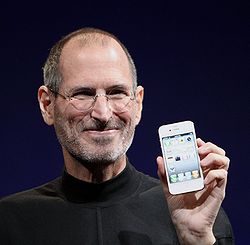
Jobs holding a white iPhone 4 at Worldwide Developers Conference 2010
|
|
| Born | Steven Paul Jobs February 24 1955 [1][2] San Francisco, California, U.S.[1][2] |
|---|---|
| Died | October 5 2011 (aged 56)[2] Palo Alto, California, U.S. |
| Cause of death | Metastatic Insulinoma |
| Nationality | American |
| Alma mater | Reed College (dropped out) |
| Occupation | Co-founder, Chairman and CEO, Apple Inc. Co-founder and CEO, Pixar Founder and CEO, NeXT Inc. |
| Years active | 1974–2011 |
| Board member of | The Walt Disney Company Apple Inc. |
| Religious beliefs | Zen Buddhism (previously Lutheran)[3] |
| Spouse(s) | Laurene Powell (1991–2011, his death) |
| Children | Lisa Brennan-Jobs Reed Jobs Erin Jobs Eve Jobs |
| Relatives | Patricia Ann Jobs (adoptive sister), Mona Simpson (biological sister) |
| Signature
|
|
Steven Paul "Steve" Jobs (February 24, 1955 – October 5, 2011) was an American entrepreneur and inventor, best known as the co-founder, chairman, and CEO of Apple Inc. At the time of his resignation from Apple, and again after his death, Jobs was widely described as a visionary, pioneer, and genius—perhaps one of the foremost—in the field of business, innovation, and product design. He profoundly changed the face of the modern world and was an "exemplar for all chief executives."
Through Apple, Jobs was widely recognized as a charismatic pioneer of the personal computer revolution and for his influential career in the computer and consumer electronics fields. As CEO of the company, Jobs oversaw the development of the iMac, iTunes, iPod, iPhone, and iPad, and on the services side, the company's Apple Retail Stores, iTunes Store, and the App Store. The success of these products and services provided several years of stable financial returns, and propelled Apple to become the world's most valuable publicly traded company in 2011.
Jobs also co-founded and served as chief executive of Pixar Animation Studios, and he became a member of the board of directors of The Walt Disney Company in 2006 when Disney acquired Pixar.
Jobs received a number of honors and public recognition for his influence in the technology and music industries. At the time of his death, following a decade of ill health, he was actively involved in designing new products and had he lived longer would no doubt have continued to make contributions to advance society in unique ways.
Life
Childhood and education
Steven Paul Jobs was born in San Francisco on February 24, 1955 to two university students, Joanne Carole Schieble, of Swiss Catholic descent, and Syrian-born Abdulfattah "John" Jandali (Arabic: عبدالفتاح جندلي), who were both unmarried at the time.[4] The baby was adopted at birth by Paul Reinhold Jobs (1922–1993) and Clara Jobs (1924–1986), an Armenian American whose maiden name was Hagopian.[5] According to Steve Jobs' commencement address at Stanford, Schieble wanted Jobs to be adopted only by a college-graduate couple. Schieble learned that Clara Jobs had not graduated from college and Paul Jobs had only attended high school, but signed final adoption papers after they promised her that the child would definitely be encouraged and supported to attend college. Later, when asked about his "adoptive parents," Jobs replied emphatically that Paul and Clara Jobs "were my parents."[6] He stated in his authorized biography that they "were my parents 1,000%."[7] Unknown to him, his biological parents would subsequently marry (December 1955), have a second child, novelist Mona Simpson, in 1957, and divorce in 1962.[7] In the 1980s, Jobs found his birth mother, Joanne Schieble Simpson, who told him he had a biological sister, Mona Simpson. They met for the first time in 1985[8] and became close friends. The siblings kept their relationship secret until 1986, when Mona introduced him at a party for her first book.[6]
The Jobs family moved from San Francisco to Mountain View, California when Steve was five years old.[1][2] They later adopted a daughter, Patty. Clara Jobs was an accountant[6] who taught him to read before he went to school.[1] Paul worked as a mechanic and a carpenter, and taught his son rudimentary electronics and how to work with his hands.[1]
The young Steve Jobs was frustrated over formal schooling. At Monta Loma Elementary school in Mountain View, he frequently played pranks on others.[9] Though school officials recommended that he skip two grades on account of his test scores, his parents elected for him only to skip one grade.[7] Jobs then attended Cupertino Junior High and Homestead High School in Cupertino, California.[2] At Homestead, Jobs became friends with Bill Fernandez, a neighbor who shared the same interests in electronics. Fernandez introduced Jobs to another, older computer whiz kid, Steve Wozniak.[10]
Following high school graduation in 1972, Jobs enrolled at Reed College in Portland, Oregon. Reed was an expensive college which Paul and Clara could ill afford. They were spending much of their life savings on their son's higher education.[10] Jobs dropped out of college after six months and spent the next 18 months dropping in on creative classes, including a course on calligraphy.[11] He continued auditing classes at Reed while sleeping on the floor in friends' dorm rooms, returning soda bottles for food money, and getting weekly free meals at the local Hare Krishna temple. [12] Jobs later said, "If I had never dropped in on that single calligraphy course in college, the Mac would have never had multiple typefaces or proportionally spaced fonts."[12]
Before Apple
In 1974, Jobs took a job as a technician at Atari, Inc. in Los Gatos, California.[13] Together with a Reed College friend (and, later, an early Apple employee), Daniel Kottke, he traveled to India in mid-1974 to visit Neem Karoli Baba at his Kainchi Ashram, in search of spiritual enlightenment. When they reached the Neem Karoli ashram it was almost deserted as Neem Karoli Baba had died in September 1973.[13]
After staying for seven months, Jobs left India[14] and returned to the US ahead of Daniel Kottke.[13] Jobs had changed his appearance; his head was shaved and he wore traditional Indian clothing.[15] During this time, Jobs experimented with psychedelics, later calling his LSD experiences "one of the two or three most important things [he had] done in [his] life."[16] He also became a serious practitioner of Zen Buddhism, engaged in lengthy meditation retreats at the Tassajara Zen Mountain Center, the oldest Sōtō Zen monastery in the US.[17] He considered taking up monastic residence at Eihei-ji in Japan, and maintained a lifelong appreciation for Zen.[18] Jobs would later say that people around him who did not share his countercultural roots could not fully relate to his thinking.[16]
Jobs then returned to Atari, where he resumed his friendship with Steve Wozniak. Wozniak had designed a low-cost digital "blue box" to generate the necessary tones to manipulate the telephone network, allowing free long-distance calls, and Jobs realized that they could make money selling it.[19]
Jobs began attending meetings of the Homebrew Computer Club with Wozniak in 1975.[2] He greatly admired Edwin H. Land, the inventor of instant photography and founder of Polaroid Corporation, and would explicitly model his own career after that of Land's.[20]
After forming Apple
In 1976, Jobs and Wozniak formed their own business, which they named "Apple Computer Company" in remembrance of a happy summer Jobs had spent picking apples.
Jobs' first child, Lisa Brennan-Jobs, was born in 1978, the daughter of his longtime partner Chris Ann Brennan, a Bay Area painter.[21] Jobs later married Laurene Powell on March 18, 1991, in a ceremony at the Ahwahnee Hotel in Yosemite National Park. Presiding over the wedding was Kobun Chino Otogawa, a Zen Buddhist monk. Their son, Reed, was born September 1991, followed by daughters Erin in August 1995, and Eve in 1998.[22]
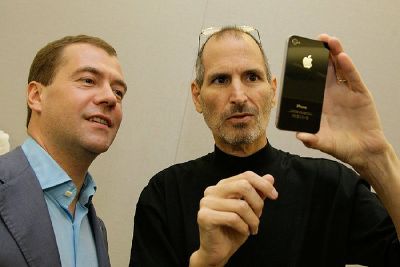
Jobs usually wore a black long-sleeved mock turtleneck made by Issey Miyake (that was sometimes reported to be made by St. Croix), Levi's 501 blue jeans, and New Balance 991 sneakers. He told biographer Walter Isaacson "...he came to like the idea of having a uniform for himself, both because of its daily convenience (the rationale he claimed) and its ability to convey a signature style."[7]
Health issues and death
In October 2003, Jobs was diagnosed with pancreatic cancer, a rare form treatable by surgery. Despite his diagnosis, Jobs resisted his doctors' recommendations for mainstream medical intervention for nine months,[21] instead trying a special alternative medicine diet, acupuncture, and other remedies in an attempt to thwart the disease. According to Jobs' biographer, Walter Isaacson, "for nine months he refused to undergo surgery for his pancreatic cancer – a decision he later regretted as his health declined."[7] He eventually underwent a pancreaticoduodenectomy (or "Whipple procedure") in July 2004, that appeared to successfully remove the tumor.[23] During Jobs' absence, Tim Cook, head of worldwide sales and operations at Apple, ran the company.[24]
Jobs returned to work after a short recovery period. However, in 2006 his appearance and uninspired presentation at Apple's annual Worldwide Developers Conference led to speculation about his health. Two years later, similar concerns followed Jobs' 2008 WWDC keynote address. On December 16, 2008, Apple announced that marketing vice-president Phil Schiller would deliver the company's final keynote address at the Macworld Conference and Expo 2009, again reviving questions about Jobs' health. In a statement given on January 5, 2009, on Apple.com, Jobs said that he had been suffering from a "hormone imbalance" for several months.[23] In an internal Apple memo a week later, Jobs wrote that in the previous week he had "learned that my health-related issues are more complex than I originally thought," and announced a six-month leave of absence until the end of June 2009, to allow him to better focus on his health. Tim Cook, who previously acted as CEO in Jobs' 2004 absence, became acting CEO of Apple, with Jobs still involved with "major strategic decisions."[23]
In April 2009, Jobs underwent a liver transplant at Methodist University Hospital Transplant Institute in Memphis, Tennessee. His prognosis was described as "excellent".[25]
On January 17, 2011, a year and a half after Jobs returned from his liver transplant, Apple announced that he had been granted a medical leave of absence. Jobs announced his leave in a letter to employees, stating his decision was made "so he could focus on his health." As during his 2009 medical leave, Apple announced that Tim Cook would run day-to-day operations and that Jobs would continue to be involved in major strategic decisions at the company.[26] Jobs announced his resignation as Apple's CEO on August 24, 2011, writing to the board, "I have always said if there ever came a day when I could no longer meet my duties and expectations as Apple’s CEO, I would be the first to let you know. Unfortunately, that day has come."[23] Jobs became chairman of the board thereafter, with Tim Cook his successor as CEO.[27]
Jobs died at his California home around 3 pm on October 5, 2011, with his wife, children, and sister at his side. [28] His death was widely mourned and considered a loss to the world by commentators across the globe.
A small private funeral was held on October 7, 2011. On October 16, an invitation-only memorial was held at Stanford University. Those in attendance included Apple and other tech company executives, members of the media, celebrities, close friends of Jobs, and politicians, along with Jobs' family. Bono, Yo Yo Ma, and Joan Baez performed at the service.[29] A private memorial service for Apple employees was held on October 19, 2011, on the Apple Campus in Cupertino. Present were Cook, Bill Campbell, Norah Jones, Al Gore, and Coldplay, and Jobs' widow, Laurene, was in attendance. Some of Apple's retail stores closed briefly so employees could attend the memorial.
Jobs is buried in Alta Mesa Memorial Park, the only non-denominational cemetery in Palo Alto.[30]
Career
Through the Apple company Steve Jobs founded, he became widely recognized as a charismatic pioneer of the personal computer revolution.[31] His influential career in the computer and consumer electronics fields transformed "one industry after another, from computers and smartphones to music and movies..."[32] Jobs was among the first to see the commercial potential of Xerox PARC's mouse-driven graphical user interface, which led to the creation of the Apple Lisa and, one year later, the Macintosh. He also played a role in introducing the LaserWriter, one of the first widely available laser printers, to the market.[33] Jobs also co-founded and served as chief executive of Pixar Animation Studios; he became a member of the board of directors of The Walt Disney Company in 2006, when Disney acquired Pixar.
Apple Computer

Jobs and Steve Wozniak had met in 1971, when their mutual friend, Bill Fernandez, introduced 21-year-old Wozniak to 16-year-old Jobs. In 1976, Wozniak invented what became the Apple I computer. Jobs, Wozniak, and Ronald Wayne, another co-worker at Atari, founded Apple computer in the garage of Jobs' parents in order to sell it.[22] They received funding from a then-semi-retired Intel product-marketing manager and engineer Mike Markkula.[34]
While Jobs was a persuasive and charismatic director for Apple, some of his employees from that time described him as an erratic and temperamental manager. Disappointing sales caused a deterioration in Jobs' working relationship with CEO John Sculley, and a power struggle between the two developed.[35] Sculley learned that Jobs had been attempting to organize a boardroom coup, and on May 24, 1985, called a board meeting to resolve the matter. Apple's board of directors sided with Sculley and removed Jobs from his managerial duties as head of the Macintosh division.[35][36] Jobs resigned from Apple five months later and founded NeXT Inc. the same year.
In the commencement speech Jobs gave at Stanford University in 2005, he said being fired from Apple was the best thing that could have happened to him; "The heaviness of being successful was replaced by the lightness of being a beginner again, less sure about everything. It freed me to enter one of the most creative periods of my life." And he added, "I'm pretty sure none of this would have happened if I hadn't been fired from Apple. It was awful-tasting medicine, but I guess the patient needed it."[37]
NeXT Computer
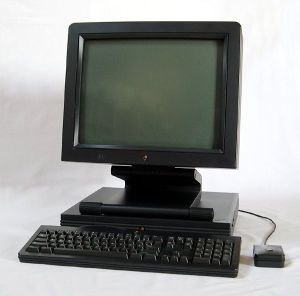
After leaving Apple, Jobs founded NeXT Computer in 1985. A year later, Jobs was running out of money, and with no product on the horizon, he appealed for venture capital. Eventually, he attracted the attention of billionaire Ross Perot who invested heavily in the company.[22] NeXT workstations were first released in 1990, and were known for their technical strengths, chief among them the object-oriented software development system. Jobs marketed NeXT products to the financial, scientific, and academic community, highlighting their innovative, experimental new technologies, such as the Mach kernel, the digital signal processor chip, and the built-in Ethernet port. Tim Berners-Lee invented the World Wide Web on a NeXT computer at CERN.[38]
The revised, second-generation NeXTcube was also released in 1990. Jobs touted it as the first "interpersonal" computer that would replace the personal computer. With its innovative NeXTMail multimedia email system, NeXTcube could share voice, image, graphics, and video in email for the first time. "Interpersonal computing is going to revolutionize human communications and groupwork," Jobs told reporters.[39] Jobs ran NeXT with an obsession for aesthetic perfection, as evidenced by the development of and attention to NeXTcube's magnesium case.[40] This put considerable strain on NeXT's hardware division, and in 1993, after having sold only 50,000 machines, NeXT transitioned fully to software development with the release of NeXTSTEP/Intel.[41] The company reported its first profit of $1.03 million in 1994.[22] In 1996, NeXT Software, Inc. released WebObjects, a framework for Web application development. After NeXT was acquired by Apple Inc. in 1997, WebObjects was used to build and run the Apple Store,[41] MobileMe services, and the iTunes Store.
Pixar and Disney
Meanwhile, in 1986 Jobs had acquired a controlling interest in Pixar, Lucasfilm's computer graphics division. The first film produced by the partnership, Toy Story (1995) brought fame and critical acclaim to the studio when it was released. Over the next 15 years, under Pixar's creative chief John Lasseter, the company produced numerous box-office hits including A Bug's Life (1998); Toy Story 2 (1999); Monsters, Inc. (2001); Finding Nemo (2003); The Incredibles (2004); Cars (2006); Ratatouille (2007); WALL-E (2008); Up (2009); and Toy Story 3 (2010).
On January 24, 2006, Disney announced an agreement to purchase Pixar in an all-stock transaction worth $7.4 billion. When the deal closed, Jobs became The Walt Disney Company's largest single shareholder with approximately seven percent of the company's stock. Jobs joined the company’s board of directors and also helped oversee Disney and Pixar’s combined animation businesses.[42]
Return to Apple
In 1996, after Apple had failed to deliver its operating system, Copland, Gil Amelio turned to NeXT Computer, and the NeXTSTEP platform became the foundation for the Mac OS X.[43] Jobs returned to Apple as an advisor, and took control of the company as an interim CEO.
As the new CEO of the company, Jobs oversaw the development of the iMac, iTunes, iPod, iPhone, and iPad, and on the services side, the company's Apple Retail Stores, iTunes Store and the App Store. The success of these products and services provided several years of stable financial returns, and propelled Apple to become the world's most valuable publicly traded company in 2011.[44] The reinvigoration of the company is regarded by many commentators as one of the greatest turnarounds in business history.[45][46]
In 1996, Apple announced that it would buy NeXT for $427 million. The deal was finalized in late 1996, bringing Jobs back to the company he co-founded. Jobs became de facto chief after then-CEO Gil Amelio was ousted in July 1997. He was formally named interim chief executive in September.[47] In March 1998, to concentrate Apple's efforts on returning to profitability, Jobs terminated a number of projects, such as Newton, Cyberdog, and OpenDoc. Many employees developed a fear of encountering Jobs while riding in the elevator, "afraid that they might not have a job when the doors opened. The reality was that Jobs' summary executions were rare, but a handful of victims was enough to terrorize a whole company."[48]
With the purchase of NeXT, much of the company's technology found its way into Apple products, most notably NeXTSTEP, which evolved into Mac OS X. Under Jobs' guidance, the company increased sales significantly with the introduction of the iMac and other new products. At the 2000 Macworld Expo, Jobs officially dropped the "interim" modifier from his title at Apple and became permanent CEO, quipping that he would be using the title "iCEO".[49]
Jobs led Apple into the twenty-first century, introducing and improving upon other digital appliances. With the introduction of the iPod portable music player, iTunes digital music software, and the iTunes Store, the company made forays into consumer electronics and music distribution. On June 29, 2007, Apple entered the cellular phone business with the introduction of the iPhone, a multi-touch display cell phone, which also included the features of an iPod and, with its own mobile browser, revolutionized the mobile browsing scene. While stimulating innovation, Jobs also reminded his employees that "real artists ship."[36]
Jobs was both admired and criticized for his consummate skill at persuasion and salesmanship, which has been dubbed the "reality distortion field" and was particularly evident during his keynote speeches at Macworld Expos and at Apple Worldwide Developers Conferences.
Business life
Management style
Jobs was a demanding perfectionist who always aspired to position his businesses and their products at the forefront of the information technology industry by foreseeing and setting trends, at least in innovation and style. He summed up that self-concept at the end of his keynote speech at the Macworld Conference and Expo in January 2007, by quoting ice hockey player Wayne Gretzky:
There's an old Wayne Gretzky quote that I love. 'I skate to where the puck is going to be, not where it has been.' And we've always tried to do that at Apple. Since the very very beginning. And we always will.[50]
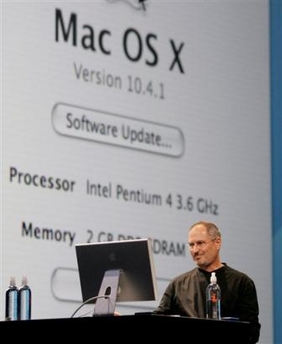
Much was made of Jobs' aggressive and demanding personality. Fortune wrote that he was "considered one of Silicon Valley's leading egomaniacs."[51] NeXT Cofounder Dan'l Lewin was quoted in Fortune as saying of that period, "The highs were unbelievable ... But the lows were unimaginable," to which Jobs' office replied that his personality had changed since then.[52]
Apple CEO Tim Cook noted, "More so than any person I ever met in my life, [Jobs] had the ability to change his mind, much more so than anyone I’ve ever met... Maybe the most underappreciated thing about Steve was that he had the courage to change his mind." [53]
Inventions and designs
Jobs' design aesthetic was influenced by the modernist architectural style of Joseph Eichler, and the industrial designs of Braun's Dieter Rams.[7] His design sense was also greatly influenced by the Buddhism which he experienced in India while on his seven-month spiritual journey.[54]
Jobs is listed as either primary inventor or co-inventor in 346 United States patents or patent applications related to a range of technologies from actual computer and portable devices to user interfaces (including touch-based), speakers, keyboards, power adapters, staircases, clasps, sleeves, lanyards and packages. Jobs' contributions to most of his patents were to "the look and feel of the product." More than 200 Apple patents are shared by Jobs with industrial design chief Jonathan Ive.[55] Most of these are design patents (specific product designs; for example, Jobs listed as primary inventor in patents for both original and lamp-style iMacs, as well as PowerBook G4 Titanium) as opposed to utility patents (inventions).
Although Jobs had little involvement in the engineering and technical side of the original Apple computers, Jobs later used his CEO position to directly involve himself with product design.[56] According to Apple cofounder, Steve Wozniak, "Steve didn't ever code. He wasn't an engineer and he didn't do any original design..."[57] Daniel Kottke, one of Apple's earliest employees and a college friend of Jobs', stated that "Between Woz and Jobs, Woz was the innovator, the inventor. Steve Jobs was the marketing person."[58]
Wealth and Philanthropy
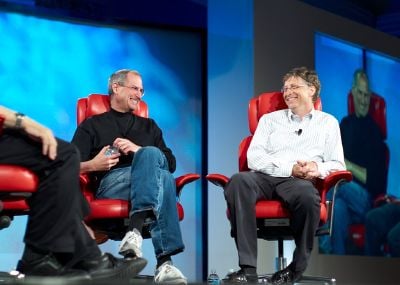
Although Jobs earned only $1 a year as CEO of Apple, Jobs held 5.426 million Apple shares worth $2.1 billion, as well as 138 million shares in Disney (which he received in exchange for Disney's acquisition of Pixar) worth $4.4 billion.[59]
Jobs was not widely known for his association with philanthropic causes compared to Bill Gates' efforts. In contrast to Gates, Jobs did not sign the Giving Pledge of Warren Buffett which challenged the world's richest billionaires to give at least half their wealth to charity.[60] In an interview with Playboy in 1985, Jobs said in respect to money that "the challenges are to figure out how to live with it and to reinvest it back into the world which means either giving it away or using it to express your concerns or values."[61] Jobs also said that when he had time he would start a public foundation but until then he did charitable acts privately.[62]
After resuming control of Apple in 1997, Jobs initially eliminated all corporate philanthropy programs.[21] Jobs' friends told The New York Times that he felt that expanding Apple would have done more good than giving money to charity.[60] Later, under Jobs, Apple signed to participate in Product Red program, producing red versions of devices to give profits from sales to the Global Fund, which fights AIDS, tuberculosis, and malaria. The co-founder of the Product Red project, singer Bono cited Jobs saying there was "nothing better than the chance to save lives," when he initially approached Apple with the invitation to participate in the program. [63]
Legacy
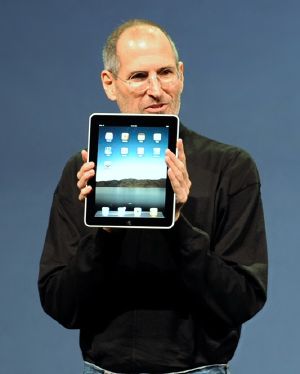
Jobs has been referred to as "legendary," a "futurist," or simply "visionary,"[64][65] and has been described as the "Father of the Digital Revolution," a "master of innovation,"[66] and a "design perfectionist."[67]
After founding Apple's, Jobs became a symbol of his company and industry. His death was announced by Apple:
We are deeply saddened to announce that Steve Jobs passed away today.
Steve's brilliance, passion and energy were the source of countless innovations that enrich and improve all of our lives. The world is immeasurably better because of Steve.
His greatest love was for his wife, Laurene, and his family. Our hearts go out to them and to all who were touched by his extraordinary gifts.[68]
Apple flew their flags at half-staff throughout their headquarters and campus,[69] as did Microsoft. [70]
For two weeks following his death, Apple's corporate Web site displayed a simple page, showing Jobs' name and lifespan next to his grayscale portrait. Clicking on the image led to an obituary, which read:
Apple has lost a visionary and creative genius, and the world has lost an amazing human being. Those of us who have been fortunate enough to know and work with Steve have lost a dear friend and an inspiring mentor. Steve leaves behind a company that only he could have built, and his spirit will forever be the foundation of Apple.[71]
An email address was also posted for the public to share their memories, condolences, and thoughts.[72] Over a million tributes were sent, which are now displayed on the Steve Jobs memorial page.
Also dedicating its homepage to Jobs was Pixar, with a photo of Jobs, John Lasseter and Edwin Catmull, and the eulogy they wrote:
Steve was an extraordinary visionary, our very dear friend, and our guiding light of the Pixar family. He saw the potential of what Pixar could be before the rest of us, and beyond what anyone ever imagined. Steve took a chance on us and believed in our crazy dream of making computer animated films; the one thing he always said was to 'make it great.' He is why Pixar turned out the way we did and his strength, integrity, and love of life has made us all better people. He will forever be part of Pixar's DNA. Our hearts go out to his wife Laurene and their children during this incredibly difficult time.[73]
In her eulogy to Jobs at his memorial service, Jobs' biological sister Mona Simpson said:
I grew up as an only child, with a single mother. Because we were poor and because I knew my father had emigrated from Syria, I imagined he looked like Omar Sharif. I hoped he would be rich and kind and would come into our lives (and our not yet furnished apartment) and help us. Later, after I'd met my father, I tried to believe he'd changed his number and left no forwarding address because he was an idealistic revolutionary, plotting a new world for the Arab people. Even as a feminist, my whole life I'd been waiting for a man to love, who could love me. For decades, I'd thought that man would be my father. When I was 25, I met that man and he was my brother.[8]
Honors and public recognition
Jobs was awarded the National Medal of Technology by President Ronald Reagan in 1985, with Steve Wozniak (among the first people to ever receive the honor),[74] and a Jefferson Award for Public Service in the category "Greatest Public Service by an Individual 35 Years or Under" (also known as the Samuel S. Beard Award) in 1987.[75] Jobs was named Entrepreneur of the Decade in 1989, by Inc. magazine.[76]
On November 27, 2007, Jobs was named the most powerful person in business by Fortune magazine.[33] On November 5, 2009, Jobs was named the CEO of the decade by Fortune magazine.[77] In November 2010, Jobs was ranked No.17 on Forbes: The World's Most Powerful People.[78]
On February 12, 2012, Jobs was posthumously awarded the Grammy Trustees Award, an award for those who have influenced the music industry in areas unrelated to performance.[79]
In March 2012, global business magazine Fortune named Steve Jobs the "greatest entrepreneur of our time," describing him as "brilliant, visionary, inspiring," and "the quintessential entrepreneur of our generation".[80]
Portrayals in media
Documentaries
- The Machine That Changed the World Part 3 of this 1992 five-part documentary, called The Paperback Computer, prominently featured Jobs and his role in the early days of Apple.
- Triumph of the Nerds a 1996 three-part documentary for PBS, about the rise of the home computer/personal computer.
- Nerds 2.0.1 a 1998 three-part documentary for PBS, (and sequel to Triumph of the Nerds) which chronicles the development of the Internet.
- iGenius: How Steve Jobs Changed the World a 2011 Discovery Channel documentary hosted by Adam Savage and Jamie Hyneman.[81]
- Steve Jobs: One Last Thing a 2011 PBS documentary produced by Pioneer Productions.[82]
Films
- Steve Jobs A Sony Pictures film version of the biography by Walter Isaacson, with a screenplay and directed by Aaron Sorkin.
- Jobs an independent film by Joshua Michael Stern, with Jobs portrayed by Ashton Kutcher.[83]
- Pirates of Silicon Valley a 1999 TNT film which chronicles the rise of Apple and Microsoft from the early 1970s to 1997. Jobs is portrayed by Noah Wyle.[84]
Theater
- The Agony and Ecstasy of Steve Jobs – The Public Theater, New York City, 2012, starring Mike Daisey.[85]
Notes
- ↑ 1.0 1.1 1.2 1.3 1.4 Smithsonian Oral and Video Histories: Steve Jobs Smithsonian Institution, April 20, 1995. Retrieved November 19, 2022.
- ↑ 2.0 2.1 2.2 2.3 2.4 2.5 John Markoff, Steven P. Jobs, 1955–2011: Apple's Visionary Redefined Digital Age The New York Times, October 5, 2011. Retrieved November 19, 2022.
- ↑ Fionna Agomuoh, Steve Jobs: Died Buddhist, Raised Lutheran Christian Post, October 7, 2011. Retrieved November 19, 2022.
- ↑ Tributes for Apple 'visionary' Steve Jobs BBC News, October 6, 2011. Retrieved November 19, 2022.
- ↑ Shirin Sadeghi, Steve Jobs Was an Arab American Huff Post, October 6, 2011. Retrieved November 19, 2022.
- ↑ 6.0 6.1 6.2 Steve Lohr, Creating Jobs The New York Times, January 12, 1997. Retrieved November 19, 2022.
- ↑ 7.0 7.1 7.2 7.3 7.4 7.5 Walter Isaacson, Steve Jobs (New York, NY: Simon and Schuster, 2012, ISBN 978-1451648539).
- ↑ 8.0 8.1 Mona Simpson, A Sister’s Eulogy for Steve Jobs The New York Times, October 30, 2011. Retrieved November 19, 2022.
- ↑ Steve Jobs: Early Life A+E Television Networks. Retrieved November 19, 2022.
- ↑ 10.0 10.1 The Jobs Family, All about Steve Jobs. Retrieved November 19, 2022.
- ↑ Duncan Campbell, The Guardian Profile: Steve Jobs The Guardian, June 8, 2004. Retrieved November 19, 2022.
- ↑ 12.0 12.1 'You've got to find what you love,' Jobs says. Prepared text of the Commencement address delivered by Steve Jobs, CEO of Apple Computer and of Pixar Animation Studios, on June 12, 2005, Stanford Report, June 14, 2005. Retrieved November 19, 2022.
- ↑ 13.0 13.1 13.2 Shashank Chouhan, An exclusive interview with Daniel Kottke India Today, September 13, 2011. Retrieved November 19, 2022.
- ↑ Arun Kumar, Wandering in India for 7 months: Steve Jobs Yahoo News, October 24, 2011. Retrieved November 19, 2022.
- ↑ Amanda Andrews, Steve Jobs, Apple's iGod: Profile The Daily Telegraph, January 14, 2009. Retrieved November 19, 2022.
- ↑ 16.0 16.1 John Markoff, What the Dormouse Said: How the Sixties Counterculture Shaped the Personal Computer Industry (Penguin, 2006, ISBN 0143036769).
- ↑ Steve Silberman, What Kind of Buddhist was Steve Jobs, Really? NeuroTribes, October 28, 2011. Retrieved November 19, 2022.
- ↑ Daniel Burke, Steve Jobs' private spirituality now an open book PC(USA), November 14, 2011. Retrieved November 19, 2022.
- ↑ Steve Jobs and the Early Apple Years I Programmer, October 6, 2011. Retrieved November 19, 2022.
- ↑ The story of Polaroid inventor Edwin Land, one of Steve Jobs' biggest heroes Retrieved November 19, 2022.
- ↑ 21.0 21.1 21.2 Peter Elkind, The trouble with Steve Jobs Fortune, March 5, 2008. Retrieved November 19, 2022.
- ↑ 22.0 22.1 22.2 22.3 Owen W. Linzmayer, Apple Confidential 2.0: The Definitive History of the World's Most Colorful Company (No Starch Press, 2004, ISBN 1593270100).
- ↑ 23.0 23.1 23.2 23.3 Dan Childs and Kevin Dolak, Steve Jobs' Pancreatic Cancer: A Timeline ABC News, October 6, 2011. Retrieved November 19, 2022.
- ↑ Benny Evangelista, Apple's Jobs has cancerous tumor removed / He'll take a month off to recuperate San Francisco Chronicle, August 2, 2004. Retrieved November 19, 2022.
- ↑ Steve Jobs recovering after liver transplant CNN, June 23, 2009. Retrieved November 19, 2022.
- ↑ Steve Jobs to take medical leave of absence but remain Apple CEO Apple Insider, January 17, 2011. Retrieved November 19, 2022.
- ↑ Luke Dormehl, Today in Apple history: Steve Jobs resigns as Apple CEO Cult of Mac, AUGUST 24, 2022. Retrieved November 19, 2022.
- ↑ Dominic Rushe, Steve Jobs, Apple co-founder, dies at 56 The Guardian, October 6, 2011. Retrieved November 19, 2022.
- ↑ Friends, family & colleagues of Steve Jobs spoke at 'moving' memorial AppleInsider, October 17, 2011. Retrieved November 19, 2022.
- ↑ Steve Jobs Find a Grave. Retrieved November 19, 2022.
- ↑ Frederick E. Allen, Malcolm Gladwell Gets Steve Jobs Wrong Forbes, November 9, 2011. Retrieved November 21, 2022.
- ↑ David Sarno and Christopher Goffard, Steve Jobs dies at 56; Apple's co-founder transformed computers and culture Los Angeles Times, October 6, 2011. Retrieved November 21, 2022.
- ↑ 33.0 33.1 Brent Schlender, 25 most powerful people in business CNN money. Retrieved November 21, 2022.
- ↑ John Markoff, An 'Unknown' Co-Founder Leaves After 20 Years of Glory and Turmoil The New York Times, September 1, 1997. Retrieved November 21, 2022.
- ↑ 35.0 35.1 Chris Seibold, May 24, 1985: Jobs Fails to Oust Sculley Apple Matters, May 24, 2011. Retrieved November 21, 2022.
- ↑ 36.0 36.1 Steven Levy, Insanely Great: The Life and Times of Macintosh, the Computer That Changed Everything (Penguin Books, 2000, ISBN 978-0140291773).
- ↑ John Naughton, Steve Jobs: Stanford commencement address, June 2005 The Guardian, October 8, 2011. Retrieved November 21, 2022.
- ↑ Welcome to info.cern.ch: The website of the world's first-ever web server, CERN (European Organization for Nuclear Research). Retrieved November 21, 2022.
- ↑ Interpersonal computing- the third revolution? New Straits Times, May 31, 1990. Retrieved November 21, 2022.
- ↑ Randall E. Stross, Steve Jobs & the NeXT Big Thing (Scribner, 1993, ISBN 0689121350), 117, 120, 246.
- ↑ 41.0 41.1 Jason D. O'Grady, Apple Inc (Greenwood Press, 2008, ISBN 0313362440).
- ↑ Steve Jobs, 1955 – 2011 Splashnology. Retrieved November 21, 2022.
- ↑ Life after Steve Jobs: What to Expect from the Next Generation at Apple Knowledge@Wharton, October 12, 2011. Retrieved November 21, 2022.
- ↑ Nick Bilton, Apple Is the Most Valuable Company New York Times, August 9, 2011. Retrieved November 21, 2022.
- ↑ Michael Hiltzik, Steve Jobs: More than a turnaround artist Los Angeles Times, October 5, 2011. Retrieved November 21, 2022.
- ↑ Conrad Quilty-Harper, Steve Jobs at Apple: a relentless rise in graphs and charts The Telegraph, October 6, 2011. Retrieved November 21, 2022.
- ↑ Apple Formally Names Jobs as Interim Chief The New York Times, September 17, 1997. Retrieved November 21, 2022.
- ↑ Alan Deutschman, The once and future Steve Jobs Salon.com, October 11, 2000. Retrieved November 21, 2022.
- ↑ Henry Norr, MacWorld Expo/Permanent Jobs/Apple CEO finally drops 'interim' from title San Francisco Chronicle, January 6, 2000. Retrieved November 21, 2022.
- ↑ Ryan Block, Live from Macworld 2007: Steve Jobs keynote January 9, 2007. Retrieved November 21, 2022.
- ↑ Geoff Colvin, Steve Jobs' Bad Bet Fortune, March 19, 2007. Retrieved November 21, 2022.
- ↑ Brian Dumaine, America's Toughest Bosses Fortune, October 18, 1993. Retrieved November 21, 2022.
- ↑ Josh Tyrangiel, Tim Cook's Freshman Year: The Apple CEO Speaks Bloomberg Businessweek, December 6, 2012. Retrieved November 21, 2022.
- ↑ Steve Jobs' autobiography: a chronicle of a complex genius The Hindu News, October 24, 2011. Retrieved November 21, 2022.
- ↑ Chris Smith, Portfolio of over 300 patents underscores Steve Jobs' attention to detail Apple Insider, August 25, 2011. Retrieved November 21, 2022.
- ↑ Megan Rose Dickey, Steve Jobs Told Me Why He Loved Being A CEO Business Insider, January 23, 2013. Retrieved November 21, 2022.
- ↑ Cliff Kuang, What Made Steve Jobs so Great? Retrieved November 21, 2022.
- ↑ Avi Solomon, Searching for Magic in India and Silicon Valley: An Interview with Daniel Kottke, Apple Employee #12 August 9, 2012. Retrieved November 21, 2022.
- ↑ Susanna Kim, Future of Steve Jobs' $6.7 Billion Wealth Likely to Remain as Private As He Was ABC News, October 7, 2011. Retrieved November 21, 2022.
- ↑ 60.0 60.1 Elizabeth Stuart, Steve Jobs' philanthropy: Did he give anonymously or not at all? Deseret News, October 12, 2011. Retrieved November 21, 2022.
- ↑ Taimur Asad, Steve Jobs Interview in Playboy (1985) Playboy, November 22, 2010. Retrieved November 21, 2022.
- ↑ Daniel Eran Dilger, Tim Cook exposes the lie that Steve Jobs ignored philanthropy AppleInsider, February 2, 2012. Retrieved November 21, 2022.
- ↑ Bono Defends Steve Jobs After Criticism About Apple Ex-CEO's Philanthropy Bloomberg, September 2, 2011. Retrieved November 21, 2022.
- ↑ Steve Jobs – A Farewell to the Legendary Icon Business Today, October 7, 2011. Retrieved November 21, 2022.
- ↑ Alex Goldfayn, The Traits That Made Steve Jobs Legendary Consumer Evangelists, October 14, 2011. Retrieved November 21, 2022.
- ↑ Steve Jobs: Master of Innovation SUCCESS, May 4, 2010. Retrieved November 21, 2022.
- ↑ Steve Jobs: Design perfectionist CNN, August 25, 2011. Retrieved November 21, 2022.
- ↑ Statement by Apple's Board of Directors Apple Inc., October 5, 2011. Retrieved November 21, 2022.
- ↑ Matt Rosoff, Flags On Apple Campus Are Flying At Half Mast Insider, October 5, 2011. Retrieved November 21, 2022.
- ↑ Microsoft lowers flags to half staff in tribute to Steve Jobs Network World, October 6, 2011. Retrieved November 21, 2022.
- ↑ Julianne Pepitone, Steve Jobs: The homepage tributes CNN, October 6, 2011. Retrieved November 21, 2022.
- ↑ Remembering Steve Apple Inc. Retrieved November 21, 2022.
- ↑ Simon Reynolds, Steve Jobs Pixar tribute: "An extraordinary visionary, a dear friend" Digital Spy, October 6, 2011. Retrieved November 21, 2022.
- ↑ The National Medal Of Technology Recipients 1985 Laureates Uspto.gov. Retrieved November 21, 2022.
- ↑ National Winners: Samuel S. Beard Award Jefferson Awards. Retrieved November 21, 2022.
- ↑ Bo Burlingham and George Gendron, The Entrepreneur of the Decade Inc. magazine, April 1, 1989. Retrieved November 21, 2022.
- ↑ Adam Lashinsky, The decade of Steve Fortune, November 5, 2009. Retrieved November 21, 2022.
- ↑ The World's Most Powerful People 2010 Forbes. Retrieved November 21, 2022.
- ↑ Steven Musil, Steve Jobs honored with Trustees Grammy CBS News, February 13, 2012. Retrieved November 21, 2022.
- ↑ Tim Barribeau, Fortune Names Steve Jobs "Greatest Entrepreneur Of Our Time" Fortune, March 26, 2012. Retrieved November 21, 2022.
- ↑ Jethro Nededog, "MythBusters" stars Adam Savage and Jamie Hyneman host the one-hour documentary The Hollywood Reporter, October 10, 2011. Retrieved november 21, 2022.
- ↑ Steve Jobs - One Last Thing PBS, October 5, 2011. Retrieved November 21, 2022.
- ↑ Pamela McClintock, Ashton Kutcher to Play Steve Jobs in Indie Biopic The Hollywood Reporter, April 2, 2012. Retrieved November 21, 2022.
- ↑ https://archive.ph/20120524203621/http://tech.fortune.cnn.com/2011/10/07/noah-wyle-steve-jobs/?section=magazines_fortune Noah Wyle on playing Steve Jobs] CNN Money, October 7, 2011. Retrieved November 21, 2022.
- ↑ The Agony and Ecstasy of Steve Jobs The Public Theater. Retrieved November 21, 2022.
References
ISBN links support NWE through referral fees
- Blumenthal, Karen. Steve Jobs: The Man Who Thought Different. Feiwel & Friends, 2012. ISBN 978-1250014450
- Isaacson, Walter. Steve Jobs. New York, NY: Simon and Schuster, 2012. ISBN 978-1451648539
- Levy, Steven. Insanely Great: The Life and Times of Macintosh, the Computer That Changed Everything. Penguin Books, 2000. ISBN 978-0140291773
- Linzmayer, Owen W. Apple Confidential 2.0: The Definitive History of the World's Most Colorful Company. No Starch Press, 2004. ISBN 1593270100
- Markoff, John. What the Dormouse Said: How the Sixties Counterculture Shaped the Personal Computer Industry. Penguin, 2006. ISBN 0143036769
- O'Grady, Jason D. Apple Inc. Greenwood Press, 2008. ISBN 0313362440
- Sculley, John, and John A. Byrne. Odyssey: Pepsi to Apple : A Journey of Adventure, Ideas, and the Future. Harpercollins, 1987. ISBN 978-0060157807
- Stross, Randall E. Steve Jobs & the NeXT Big Thing. Scribner, 1993. ISBN 0689121350
External links
All links retrieved November 11, 2022.
- Brenna Cammeron, Steve Jobs Dies: A Timeline Of His Health The Huffington Post, October 5, 2011.
- Steve Jobs remembrance notes from the community
- Steve Jobs in 1994: The Rolling Stone Interview, Rolling Stone, 1994, republished January 17, 2011.
- Steve Jobs's Appearances at D, the Full Video Sessions AllThingsD.
Credits
New World Encyclopedia writers and editors rewrote and completed the Wikipedia article in accordance with New World Encyclopedia standards. This article abides by terms of the Creative Commons CC-by-sa 3.0 License (CC-by-sa), which may be used and disseminated with proper attribution. Credit is due under the terms of this license that can reference both the New World Encyclopedia contributors and the selfless volunteer contributors of the Wikimedia Foundation. To cite this article click here for a list of acceptable citing formats.The history of earlier contributions by wikipedians is accessible to researchers here:
- Steve_Jobs history
The history of this article since it was imported to New World Encyclopedia:
- History of "Steve Jobs"
Note: Some restrictions may apply to use of individual images which are separately licensed.
↧ Download as ZWI file | Last modified: 02/04/2023 00:39:28 | 139 views
☰ Source: https://www.newworldencyclopedia.org/entry/Steve_Jobs | License: CC BY-SA 3.0
 ZWI signed:
ZWI signed: KSF
KSF